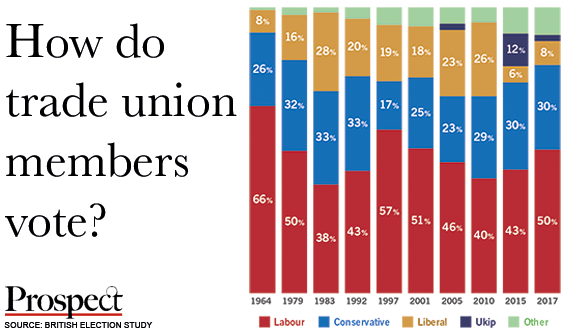Theresa May wasted no time in ditching George Osborne—but she clung on to his provocative rhetoric about turning the Conservatives into the party of “working people.” In the event, in June’s vote the Tories proved to be the party of pensioners, with Labour having the edge amongst those of working age.
Definitions of class are complex and contested. But analysis of the British Election Study (BES), published here for the first time, affirms that Labour remains the party of workers, or at least those workers in unions. As the chart shows, its vote share among union members is up seven points on 2015, and 10 on 2010—climbing from 40 to 50 per cent since Gordon Brown lost power.
Meanwhile the Tories have stagnated with around 30 per cent of the union vote in each recent election. Labour’s performance among union members is its best in 20 years, since its 1997 landslide. Its anti-austerity and pro-union manifesto may explain why; it included pledges to repeal the Trade Union Act and extend collective bargaining.

Union leaders are staunchly Labour of course, and they will be relieved to see their members reverting to what they regard as their natural political home. Only two years ago UKIP took 12 per cent of the union vote which, when combined to the Tory share, meant that 2015 was the first election where the “combined right” did virtually as well with trade unionists as Labour.
Not so in 2017. Adding UKIP (whose union share collapsed) and the Tories this time gives the right just 32 per cent of the union vote, 18 points behind Labour.
The blue workers’ party rhetoric is ringing a bit hollow.












